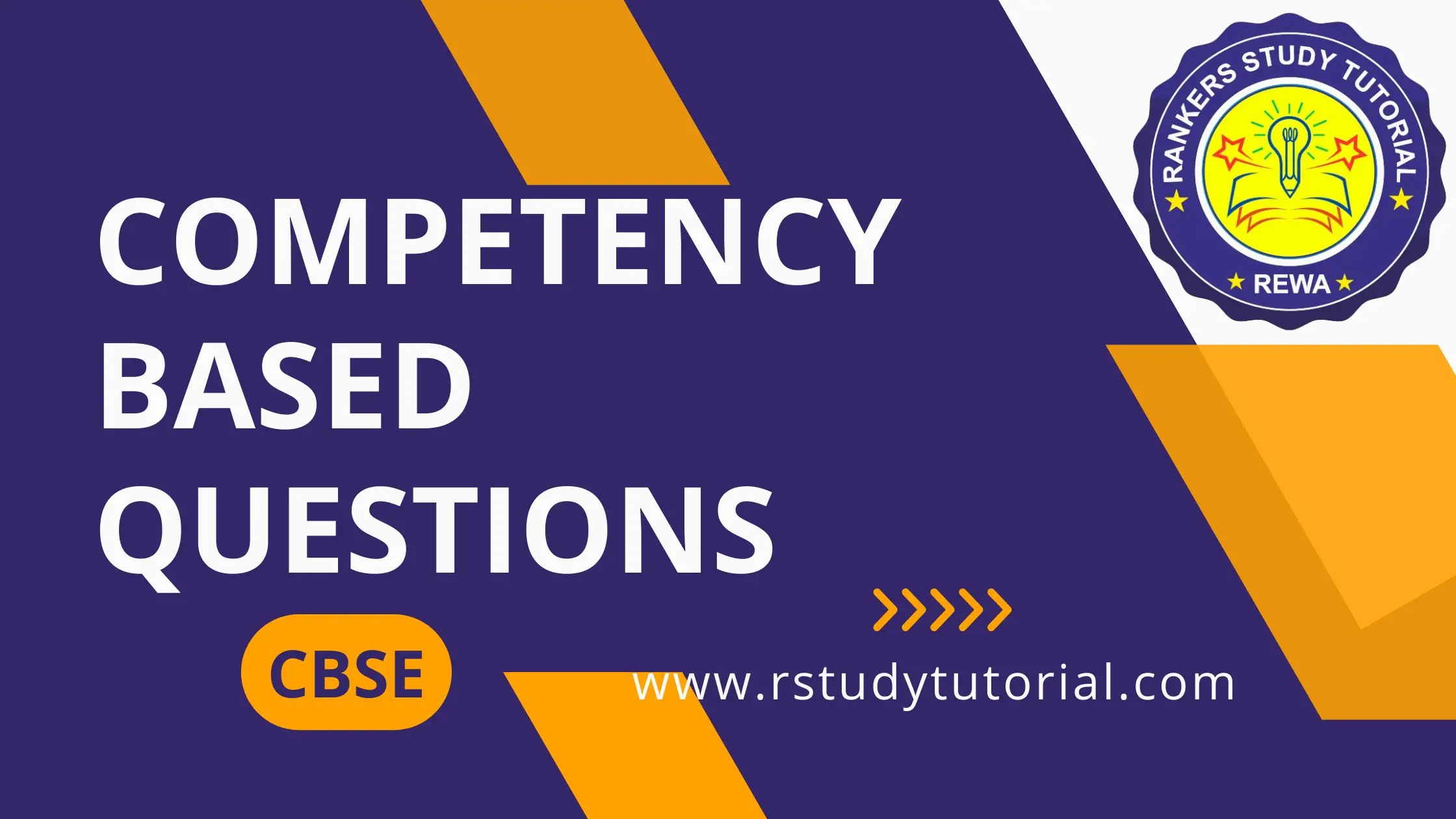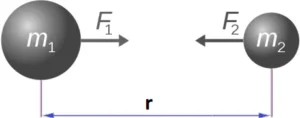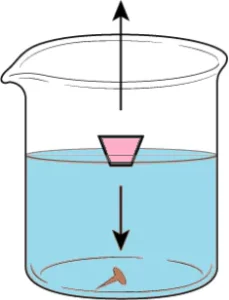Hint: Explain situations that are in coherence with concepts of motion, laws of motion and Inertia.
Question.1. Which law of motion explains the occurrence of tides due to the gravitational pull of the Moon and the Sun?
(a) Newton’s third law of motion, as their gravitational pull affects the motion of Earth.
(b) Newton’s first law of motion, as their gravitational pull changes the shape of Earth.
(c) Newton’s third law of motion, as their gravitational pull is balanced by the weight of ocean water.
(d) Newton’s second law of motion, as their gravitational pull is uniformly applied on the Earth’s oceans.
Question.2. The image shows a two blocks of mass m_{1} and m_{2} on wooden plank, which is pivoted at its center. The weights are r_{1} and r_{2} distances apart from the point of pivot.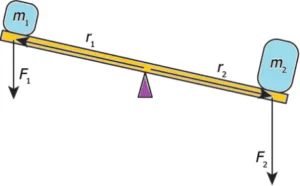
(a) When m_{1}<m_{2} and r_{1}=r_{2}.
(b) When m_{1}<m_{2} and r_{1}<r_{2}.
(c) When m_{1}>m_{2} and r_{1}>r_{2}.
(d) When m_{1}=m_{2} and r_{1}=r_{2}.
Ans.1. (c) Newton’s third law of motion, as their gravitational pull is balanced by the weight of ocean water.
Ans.2. (d) When m_{1}=m_{2} and r_{1}=r_{2}.
Hint: Demonstrate a clear understanding of gravitational force.
Question.3. “An apple falls from its tree onto the ground”. What does it tell about the nature of gravitational force?
(a) It is a repulsive force, which acts at greater heights.
(b) It is a repulsive force, which is independent of height.
(c) It is an attractive force, which acts at greater heights.
(d) It is an attractive force, which is independent of height.
Question.4. A ball is dropped from a height and the distance covered by the ball each second is recorded. The image shows the distance the ball covers each second.
(a) It causes the ball to decrease its speed of fall.
(b) It causes the ball to fall with a constant speed.
(c) It increases the distance covered by the ball with every passing second.
(d) It decreases the distance covered by the ball with every passing second.
Ans.3. (d) It is an attractive force, which is independent of height.
Ans.4. (c) It increases the distance covered by the ball with every passing second.
Hint: Explain the role of centripetal force in life situations.
Question.5. A student places a stone on a sling and moves it in circular motion, as shown.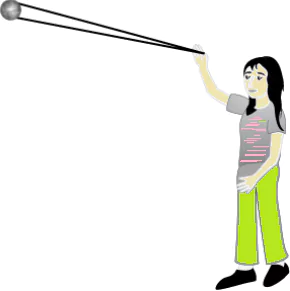
(a) It acts towards the hand.
(b) It acts towards the ground.
(c) It acts tangential to the circular motion of stone.
(d) It acts in the direction opposite to the direction of motion.
Question.6. The image shows the revolution of Moon around the Earth.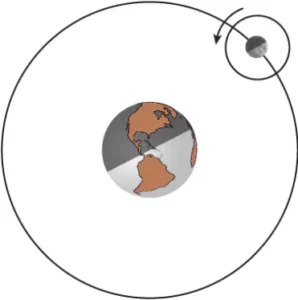
(a) It changes the distance and velocity of Moon at every point on its orbit.
(b) It changes the direction and distance of Moon at every point on its orbit.
(c) It changes the direction and velocity of Moon at every point on its orbit.
(d) It changes the speed of rotation and direction of Moon at every point on its orbit.
Ans.5. (a) It acts towards the hand.
Ans.6. (c) It changes the direction and velocity of Moon at every point on its orbit.
Hint: Relate Newton’s third law of motion and gravitational force to explain the motion of bodies.
Question.7. The image shows a model of Earth with mass m_{1} and its moon with mass m_{1}.
(a) F_{1}=F_{2}
(b) F_{1}>F_{2}
(c) F_{1}<F_{2}
(d) F_{1}=-F_{2}
Question.8. The image shows Earth with its Moon.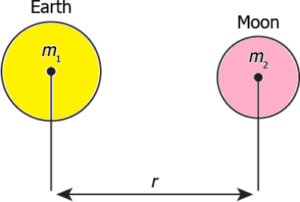
(a) The acceleration due to gravity on Earth is equal to that on Moon.
(b) The acceleration due to gravity on Earth is greater than that on Moon.
(c) Gravitational force due to the Earth on Moon is equal to that due to Moon on the Earth.
(d) Gravitational force due to the Earth on Moon is greater than that due to Moon on the Earth.
Ans.7. (d) F_{1}=-F_{2}
Ans.8. (c) Gravitational force due to the Earth on Moon is equal to that due to Moon on the Earth.
Hint: Calculate gravitational force and its impact on objects.
Question.9. The magnitude of gravitational force between two objects is F. What change will increase the magnitude of gravitational force by three times the original magnitude?
(a) distance between the objects is increased by half of the original distance
(b) distance between the objects is decreased by half of the original distance
(c) distance between the objects is decreased by one-third of the original distance
(d) distance between the objects is increased by one-third of the original distance
Question.10. The image shows two objects of mass, m_{1} and m_{2} separated by distance, r.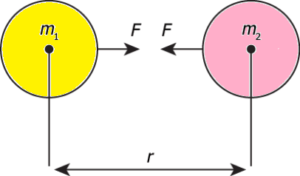
(a) 6.673\times 10^{-9} N
(b) 6.673\times 10^{-10} N
(c) 6.673\times 10^{-11} N
(d) 6.673\times 10^{-12} N
Ans.9. (b) distance between the objects is decreased by half of the original distance
Ans.10. (b) 6.673\times 10^{-10} N
Hint: Estimate the acceleration due to gravity acting on a body.
Question.11. An object has a mass of 163 kg. When the object is kept on a weighing scale, it exerts a force of 1.597\times 10^{3} N. What is the value of aceleration due to gravity?
(a) 9.8ms^{2}
(b) 9.8 ms^{-2}
(c) 9.8\times 10^{2} ms^{-2}
(d) 9.8\times 10^{-2} ms^{2}
Question.12. If the mass of a planet is 6\times 10^{26} kg and its radius is 6.4\times 10^{3} km , what is the estimated acceleration due to gravity on the surface of the planet?
(a) 9.8 ms^{-2}
(b) 9.8ms^{2}
(c) 9.8\times 10^{2} ms^{-2}
(d) 9.8\times 10^{-2} ms^{2}
Ans.11. (b) 9.8 ms^{-2}
Ans.12. (c) 9.8\times 10^{2} ms^{-2}
Hint: Relate change in acceleration due to gravity to Earth’s shape and weight of objects.
Question.13. The image shows the shape of Earth.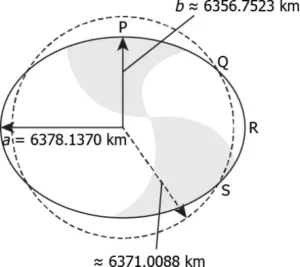
(a) P
(b) Q
(c) R
(d) S
Question.14. The image shows the distances of points P and Q from the Earth’s center.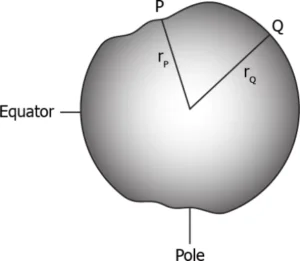
(a) g_{P}>g_{Q} and W_{P}>W_{Q}
(b) g_{P}<g_{Q} and W_{P}<W_{Q}
(c) g_{P}>g_{Q} and W_{P}<W_{Q}
(d) g_{P}<g_{Q} and W_{P}>W_{Q}
Ans.13. (a) P
Ans.14. (a) g_{P}>g_{Q} and W_{P}>W_{Q}
Hint: Calculate the magnitude of acceleration at different points on the path when the object is in motion.
Question.15. A ball is thrown vertically upwards as shown.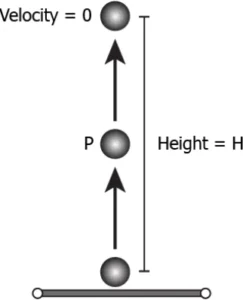
(a) a = g
(b) a = -g
(c) a > g
(d) a = 0
Question.16. The image shows the path of a ball.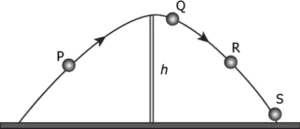
(a) P
(b) Q
(c) R
(d) S
Ans.15. (b) a = -g
Ans.16. (a) P
Hint: Interpret the relation between universal constant and acceleration due to gravity.
Question.17. Which of the following is true about the SI unit of universal constant due to gravity and the acceleration due to gravity:
(a) both have same SI unit
(b) universal constant does not have an SI unit
(c) acceleration due to gravity does not have an SI unit
(d) Both universal constant and acceleration due to gravity does not have an SI unit
Question.18. The acceleration due to the force applied by m_{1} on m_{2} in the given below configuration can be represented by:
(a) G\frac{m_{1}}{r^{2}}
(b) G\frac{m_{1}\times m_{2}}{r^{2}}
(b) G\frac{m_{2}}{r^{2}}
(d) \frac{G}{r^{2}}
Ans.17. (b) universal constant does not have an SI unit
Ans.18. (a) G\frac{m_{1}}{r^{2}}
Hint: Assess the force of gravitation exerted and compute mass of an object on earth and moon.
Question.19. The gravity on Moon is approximately one-sixth that on Earth. If an object weighs 100 N on Earth, how much would it weigh on Moon?
(a) 2.77 N
(b) 16.67 N
(c) 33.33 N
(d) 83.33 N
Question.20. An object of 5 kg mass has a weight of 8.15 N on Moon. How much would an object of 8 kg mass weigh on Moon?
(a) 11.15 N
(b) 13.04 N
(c) 49.00 N
(d) 78.40 N
Ans.19. (b) 16.67 N
Ans.20. (b) 13.04 N
Hint: Differentiate between thrust and pressure.
Question.21. What is true for thrust and pressure?
(a) Pressure varies with area, while thrust remains constant.
(b) Thrust varies with area, while pressure remains constant.
(c) Magnitude of thrust is always greater than that of pressure.
(d) Magnitude of pressure is always greater than that of thrust.
Question.22. The image shows a block of wood with height 2 cm, width 2 cm, and length 5 cm kept in two different orientations on a table.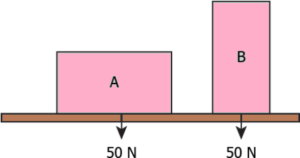
(a) Thrust of 50 N remains same, while pressure in orientation A is 5 N/cm^{2} and in orientation B is 12.5 N/cm^{2}.
(b) Thrust of 50 N remains same, while pressure in orientation A is 12.5 N/cm^{2} and in orientation B is 5 N/cm^{2}.
(c) Pressure of 50 N remains same, while thrust in orientation A is 5 N/m^{2} and in orientation B is 12.5 N/m^{2}.
(d) Pressure of 50 N remains same, while thrust in orientation A is 12.5 N/m^{2} and in orientation B is 5 N/m^{2}.
Ans.21. (a) Pressure varies with area, while thrust remains constant.
Ans.22. (a) Thrust of 50 N remains same, while pressure in orientation A is 5 N/cm^{2} and in orientation B is 12.5 N/cm^{2}.
Hint: Examine the impact of buoyant force to determine if an object will sink or float
in water.
Question.23. Why does a ship made of steel floats, while a slab of steel sinks in water?
(a) Ship has lower density than that of a slab of steel.
(b) Ship has lower mass than that of a slab of steel.
(c) Ship has greater volume than that of a slab of steel.
(d) Ship has thinner surface than that of a slab of steel.
Question.24. The image shows the forces acting on the cork floating on water.
Buoyant Force = density \times volume \times g
Weight = m \times g
What change causes the sinking of cork?
(a) increase in the product of density and volume of cork
(b) increase in the product of volume of water and density of cork
(c) decrease in the product of mass of cork and acceleration due to gravity
(d) decrease in the product of density of water and acceleration due to gravity
Ans.23. (c) Ship has greater volume than that of a slab of steel.
Ans.24. (a) increase in the product of density and volume of cork
Hint: Calculate buoyant force acting on a body and determine its impact.
Question.25. An object of length 3 m, width 1 m, and thickness 1 m is immersed in water. It displaces 2 L of water. How much buoyant force is acting on the object? (g = 10 m/s^{2})
(a) 6 N
(b) 20 N
(c) 30 N
(d) 60 N
Question.26. An object of mass 2 kg is immersed in a tank containing 98 L of water. The buoyant force acting on the object is 19.60 N. How many liters of water gets displaced by the object?
(a) 3.92 L
(b) 2.00 L
(c) 1.96 L
(d) 1.00 L
Ans.25. (b) 20 N
Ans.26. (c) 1.96 L

